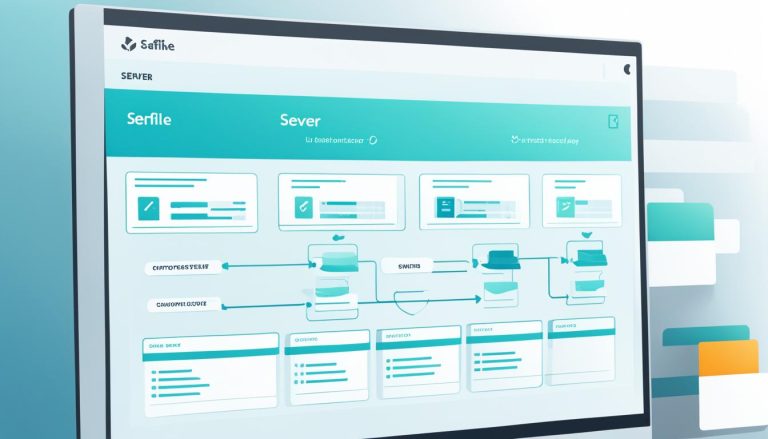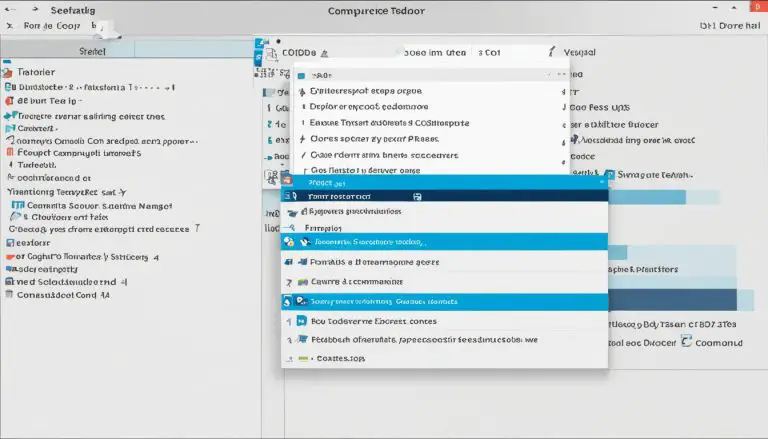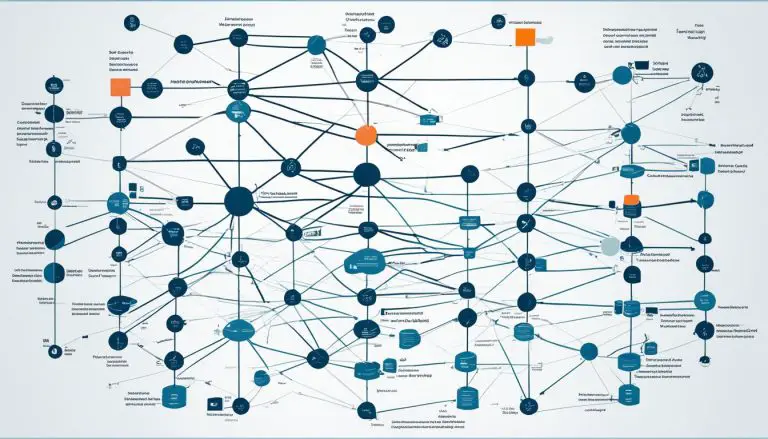Understanding What is NFS (Network File System): A Quick Guide
NFS (Network File System) is a distributed file sharing protocol that enables users to access and share files on remote systems as if they were local files. Originally developed for Unix systems in 1984, NFS has evolved into NFSv4, the current version of the protocol. Utilizing Remote Procedure Calls (RPCs), NFS routes requests between clients and servers, allowing for seamless file sharing across networks.
In a client-server model, an NFS server shares directories or files, while an NFS client accesses them. This protocol can operate over any transport or network protocol stack, but it is commonly implemented using the TCP/IP protocol suite. NFS is supported by various operating systems and cloud storage providers, making it a versatile solution for file sharing.
Key Takeaways:
- NFS is a distributed file sharing protocol that allows users to access and share files on remote systems as if they were local files
- It originated in 1984 for Unix systems and has evolved into NFSv4
- NFS uses Remote Procedure Calls (RPCs) for routing requests between clients and servers
- The protocol operates in a client-server model and can work over any transport or network protocol stack
- NFS is supported by various operating systems and cloud storage providers
The History and Evolution of NFS
NFS has a rich history and has evolved from its origins as a protocol for Unix systems to become a widely-used network file sharing solution. Introduced in 1984, NFS was developed by Sun Microsystems to allow users to access and share files on remote systems as if they were local files. Since its inception, NFS has undergone several advancements, resulting in the current version, NFSv4.
Originally, NFS was designed to provide a simple and efficient method for file sharing between Unix systems. It utilized Remote Procedure Calls (RPCs) for routing requests between clients and servers, making it a reliable and scalable protocol. Over time, NFS has been adopted by various operating systems, including Unix, Linux, and Windows, further enhancing its versatility and interoperability.
As NFS evolved, new versions were introduced to address the changing needs of users. NFSv2 and NFSv3 brought improvements in performance and security, while NFSv4 introduced significant enhancements such as improved security mechanisms, support for file locking, and increased scalability. The latest versions, NFSv4.1 and NFSv4.2, continued to refine the protocol, focusing on features like parallel network transfers and server migration.
“NFS has come a long way since its inception, evolving into a robust and widely-used network file sharing solution. With each new version, NFS has introduced improvements and added features to meet the growing requirements of users and systems.”
In the world of cloud storage, NFS has found a place as well. Cloud storage providers have implemented NFS to enable seamless file sharing and collaboration in cloud-based infrastructures. This has allowed organizations to leverage the benefits of NFS in a scalable and flexible manner, extending its capabilities beyond traditional on-premises systems.
The history and evolution of NFS demonstrate its enduring relevance and adaptability in the ever-changing landscape of network file sharing. As technology continues to advance, NFS is likely to continue evolving, with ongoing developments aimed at further improving its performance, security, and scalability.
| NFS Versions | Description |
|---|---|
| NFSv2 | The second version of NFS, introduced in 1989, with improved performance and support for larger file sizes. |
| NFSv3 | Introduced in 1995, NFSv3 added support for file locking, improved security mechanisms, and increased transfer sizes. |
| NFSv4 | The fourth version of NFS, released in 2000, brought significant enhancements in security, scalability, and file sharing capabilities. |
| NFSv4.1 | Introduced in 2008, NFSv4.1 introduced features like parallel network transfers and improved client caching. |
| NFSv4.2 | Released in 2011, NFSv4.2 added support for server migration, allowing for seamless and uninterrupted file access. |
NFS in a Client-Server Model
NFS leverages a client-server model, where the NFS server shares directories or files, and the NFS client accesses them. This model allows for efficient and centralized file sharing across a network. The NFS server acts as a central repository of files, while the NFS client can access and manipulate these files as if they were stored locally on their own system.
One of the key benefits of the client-server model is the ability to share files seamlessly between different systems and operating systems. For example, a Unix-based NFS server can share files with a Windows-based NFS client, enabling cross-platform collaboration and file sharing. This flexibility makes NFS a versatile protocol for organizations with heterogeneous computing environments.
NFS operates over any transport or network protocol stack, although it is commonly implemented on systems using the TCP/IP protocol suite. This ensures reliable and secure communication between clients and servers. By utilizing the underlying network infrastructure, NFS enables efficient file sharing without the need for additional network protocols or overhead.
In summary, NFS’s client-server model facilitates seamless file sharing and collaboration across different systems and operating systems. This model, along with the ability to operate over any transport or network protocol stack, makes NFS a widely used and versatile protocol for network file sharing.
Table: Key Components of NFS in a Client-Server Model
| NFS Server | NFS Client |
|---|---|
| Shares directories or files | Accesses shared directories or files |
| Acts as a central repository of files | Manipulates shared files as if they were local |
| Supports cross-platform collaboration | Enables seamless file sharing between systems |
| Operates over any transport or network protocol stack | Utilizes underlying network infrastructure |
Versions of NFS
NFS has evolved through multiple versions, including NFSv2, NFSv3, NFSv4, NFSv4.1, and NFSv4.2. Each version brings improvements and new features to the protocol, enhancing its performance, security, and scalability.
NFSv2
NFSv2, introduced in the early 1990s, was the first widely used version of NFS. It provided basic file sharing capabilities and relied on the UDP (User Datagram Protocol) transport protocol for communication. However, NFSv2 lacked support for strong security mechanisms, making it vulnerable to unauthorized access.
NFSv3
NFSv3, released in 1995, addressed the security limitations of NFSv2 by introducing support for the Remote Procedure Call (RPC) Secure Port Mapper protocol. This allowed for stronger authentication and encryption of NFS traffic. NFSv3 also introduced several performance enhancements, including improved caching and reduced network overhead.
NFSv4
NFSv4, released in 2000, was a significant overhaul of the protocol. It introduced a stateful model, allowing clients and servers to maintain session information, improving performance and security. NFSv4 also introduced support for access control lists (ACLs), file locking, and compound operations. It made use of the TCP (Transmission Control Protocol) transport protocol by default for reliable communication.
NFSv4.1
NFSv4.1, introduced in 2010, brought further enhancements to NFSv4. It introduced parallelized file operations, allowing for improved performance. NFSv4.1 also included support for pNFS (Parallel NFS), enabling file data to be accessed directly from storage devices rather than going through the server.
NFSv4.2
NFSv4.2, released in 2016, added new features and improvements to the protocol. It introduced support for NFS sessions, allowing clients to reconnect to servers without interrupting file operations. NFSv4.2 also introduced support for encrypted data transmission, enhancing the security of NFS traffic.
| Version | Release Year | Main Features |
|---|---|---|
| NFSv2 | Early 1990s | Basic file sharing, UDP transport |
| NFSv3 | 1995 | Improved security, RPC Secure Port Mapper, performance enhancements |
| NFSv4 | 2000 | Stateful model, ACLs, file locking, compound operations, TCP transport |
| NFSv4.1 | 2010 | Parallelized file operations, pNFS support |
| NFSv4.2 | 2016 | NFS sessions, encrypted data transmission |
Benefits of NFS
NFS provides several benefits, making it an attractive choice for network file sharing. One of the key advantages is its cost-effectiveness. NFS eliminates the need for multiple physical copies of files by allowing users to access and share files on remote systems as if they were local. This reduces hardware and storage costs, making it a cost-effective solution for organizations of all sizes.
Centralized management is another benefit of NFS. With NFS, administrators can easily manage and control access to files from a central server. This simplifies the process of granting or revoking permissions, ensuring that only authorized users can access sensitive data. Additionally, NFS supports file locking mechanisms, enabling concurrent access to files while maintaining data integrity.
Furthermore, NFS offers ease of use. Users can access remote files seamlessly as if they were on their local machine, providing a seamless and familiar experience. Additionally, NFS allows for easy integration with existing IT infrastructure and supports a wide range of operating systems, including Unix, Linux, and Windows.
| Advantages of NFS |
|---|
| Cost-effective solution |
| Centralized management of files and access control |
| Seamless and familiar user experience |
| Easy integration with existing IT infrastructure |
| Support for multiple operating systems |
Conclusion
In conclusion, NFS (Network File System) is a widely used protocol for network file sharing. It provides several benefits, including cost-effectiveness, centralized management, and ease of use. NFS allows users to access and share files on remote systems as if they were local, reducing hardware and storage costs. Administrators can easily manage file access and permissions from a central server, ensuring data security. NFS also offers a seamless and familiar user experience and supports integration with various operating systems. Overall, NFS is a reliable and efficient solution for organizations seeking efficient file sharing and collaboration.
Limitations of NFS
Despite its advantages, NFS does have certain limitations that should be considered when implementing network file sharing solutions. These limitations can impact the performance and scalability of the NFS protocol.
One of the main limitations of NFS is its reliance on network bandwidth. Since NFS operates over a network, the speed and efficiency of file transfers can be hindered by limited bandwidth. This can result in slower data transfers and increased latency, especially when dealing with large files or high network traffic.
Another limitation is the scalability of NFS. While NFS is suitable for small-scale deployments, it may struggle to handle the demands of larger environments. As the number of clients accessing the NFS server increases, the server’s performance may degrade, leading to slower response times and potential bottlenecks.
In addition, NFS does not provide built-in encryption or strong security measures. This means that data transferred between clients and servers via NFS is susceptible to eavesdropping and unauthorized access. To mitigate this limitation, additional security mechanisms such as VPNs or encryption protocols should be implemented.
| Limitations of NFS |
|---|
| Reliance on network bandwidth |
| Scalability issues in larger environments |
| Lack of built-in encryption and weak security measures |
In summary, while NFS offers benefits in terms of cost-effectiveness, centralized management, and ease of use, it is important to be aware of its limitations. Considerations should be made regarding network bandwidth, scalability, and security when implementing NFS for network file sharing.
NFS and Operating Systems Support
NFS has broad support across various operating systems, enabling seamless file sharing between different platforms. It is supported by Unix-based operating systems like Linux and macOS, as well as Windows-based systems. This wide compatibility makes NFS a versatile and widely used protocol for network file sharing.
When using NFS on Unix-based operating systems, such as Linux and macOS, it is often already built-in and readily available. This means that users can easily access NFS functionality without the need for additional software installations. NFS can be configured to share directories or files between systems, allowing for efficient collaboration and data sharing.
On Windows systems, NFS support can be added through third-party software or by enabling the NFS client feature in the operating system. This allows Windows users to connect to NFS shares hosted on Unix-based systems and access files as if they were local. NFS provides a seamless bridge between different operating systems, enabling users to work together regardless of their preferred platform.
Overall, NFS’s broad support across various operating systems makes it a reliable and widely used protocol for network file sharing. Whether you’re using Linux, macOS, or Windows, NFS offers a flexible and efficient solution for accessing and sharing files across different platforms.
| Operating System | NFS Support |
|---|---|
| Linux | Built-in NFS support |
| macOS | Built-in NFS support |
| Windows | Third-party software or NFS client feature |
NFS in Cloud Storage
NFS is extensively used in cloud storage environments, providing a reliable and efficient solution for file sharing in the cloud. With the increasing adoption of cloud-based infrastructures, NFS offers a seamless way to share and collaborate on files across different platforms and locations.
One of the key advantages of using NFS in cloud storage is its compatibility with various operating systems. NFS is supported by Unix, Linux, and Windows, making it a versatile protocol for file sharing. This means that users can easily access and manage their files on cloud storage systems, regardless of the operating system they are using.
In addition, NFS offers a high level of scalability, allowing organizations to handle large volumes of data in the cloud. NFSv4, the latest version of the protocol, includes features such as parallel data access and improved caching, which further enhance its performance and scalability in cloud environments. This means that users can access their files quickly and efficiently, even when dealing with massive datasets.
| Benefits of NFS in Cloud Storage |
|---|
| Compatibility with various operating systems (Unix, Linux, Windows) |
| Scalability to handle large volumes of data |
| Efficient parallel data access |
| Improved caching for faster file retrieval |
In conclusion, NFS plays a vital role in enabling seamless file sharing and collaboration in cloud storage environments. Its compatibility with different operating systems, scalability, and optimized performance make it a preferred choice for organizations that rely on cloud-based infrastructures for their storage needs.
Security Considerations for NFS
When using NFS, it is crucial to consider security measures that safeguard the integrity and confidentiality of shared files. NFS operates in a distributed environment, where files are accessed and shared over a network. This introduces potential vulnerabilities that can be exploited by malicious actors. Therefore, implementing robust security measures is essential to protect sensitive data.
Access Controls
One of the key security considerations for NFS is implementing proper access controls. Access controls ensure that only authorized users can access shared files and directories. NFS provides access control lists (ACLs) that allow administrators to define granular permissions for individual users or groups. By setting up appropriate access controls, organizations can prevent unauthorized access and mitigate the risk of data breaches.
Encryption
Encrypting NFS traffic is another critical security measure. Encryption protects the confidentiality of data transmitted over the network, making it unreadable to unauthorized parties. NFS supports the use of cryptographic protocols such as Secure Sockets Layer (SSL) and Transport Layer Security (TLS) to secure network communication. By enabling encryption, organizations can safeguard sensitive information from eavesdropping and interception.
Authentication Mechanisms
Implementing strong authentication mechanisms is vital to ensure that only legitimate users can access NFS resources. NFS supports various authentication methods, including the use of Secure RPC (SunRPC) and the Lightweight Directory Access Protocol (LDAP). These authentication mechanisms verify the identity of clients and servers, preventing unauthorized access and unauthorized modification of files.
| Security Considerations for NFS |
|---|
| Access Controls |
| Encryption |
| Authentication Mechanisms |
By implementing access controls, encryption, and authentication mechanisms, organizations can enhance the security of their NFS deployments. These measures ensure that sensitive files and data remain protected, minimizing the risk of unauthorized access and data breaches. It is important to regularly review and update security configurations to address emerging threats and vulnerabilities.
Performance Optimization Techniques for NFS
To achieve optimal performance with NFS, various techniques can be implemented to optimize the protocol’s speed and efficiency. These techniques focus on improving network performance, reducing latency, and maximizing throughput. Here are some key techniques:
- Network Optimization: By optimizing the network infrastructure, including switches, routers, and network interfaces, the overall performance of NFS can be significantly enhanced. Techniques such as jumbo frames, Quality of Service (QoS) prioritization, and network tuning parameters can help reduce latency and improve data transfer rates.
- Caching Strategies: NFS utilizes caching at both the client and server sides to minimize the need for frequent network requests. By implementing caching techniques, such as read-ahead caching and attribute caching, NFS can reduce the latency and bandwidth requirements associated with accessing remote files.
- I/O Scheduling: Optimizing the I/O scheduling can improve the efficiency of NFS operations. Techniques such as I/O batching, where multiple I/O requests are combined into a single operation, can reduce the overhead associated with individual requests and enhance throughput.
- Filesystem Tuning: Fine-tuning the filesystem parameters, such as block size, inode size, and buffer cache size, can have a significant impact on the performance of NFS. By aligning these parameters with the workload characteristics, NFS can achieve better read and write performance.
Overall, the performance of NFS can be greatly improved by implementing these optimization techniques. However, it is important to note that the effectiveness of these techniques may vary depending on the specific network and workload conditions. It is recommended to measure and monitor the performance impact of each technique to ensure the desired improvements are achieved.
Sample Table
| Technique | Description | Benefits |
|---|---|---|
| Network Optimization | Optimizing the network infrastructure to reduce latency and improve data transfer rates. | Reduced latency, improved throughput |
| Caching Strategies | Implementing caching techniques to minimize network requests and reduce latency. | Reduced latency, improved bandwidth utilization |
| I/O Scheduling | Optimizing the scheduling of I/O operations to reduce overhead and enhance throughput. | Improved efficiency, higher throughput |
| Filesystem Tuning | Fine-tuning filesystem parameters to align with workload characteristics and improve performance. | Better read and write performance |
NFS vs. Other File Sharing Protocols
NFS stands out among other file sharing protocols due to its unique features and capabilities, which set it apart from alternatives like SMB (Server Message Block) and FTP (File Transfer Protocol). While all these protocols facilitate file sharing over networks, NFS offers distinct advantages that make it a preferred choice in many scenarios.
One of the key differentiators of NFS is its cross-platform compatibility. Unlike SMB, which is primarily used in Windows environments, NFS is supported by various operating systems, including Unix, Linux, and Windows. This versatility makes NFS a reliable option for organizations with heterogeneous infrastructures.
| NFS | SMB | FTP |
|---|---|---|
| Supports multiple operating systems | Primarily used in Windows environments | Platform-independent |
| Efficient performance | Can be slower due to additional overhead | Can be slower due to the need for multiple round trips |
| Strong security mechanisms | Relies on Windows authentication and access controls | Basic authentication and encryption capabilities |
Another advantage of NFS is its efficient performance. It utilizes a client-server model that minimizes network overhead, resulting in faster file access and transfer speeds. On the other hand, protocols like SMB and FTP may introduce additional latency due to their design and communication mechanisms.
When it comes to security, NFS provides strong mechanisms for access control, authentication, and encryption. It allows for the implementation of robust security measures to protect data shared over the network. In comparison, SMB relies heavily on Windows authentication and access controls, while FTP offers basic authentication and encryption capabilities.
In conclusion, NFS technology, with its extensive cross-platform support, efficient performance, and robust security features, stands out as a reliable and versatile file sharing protocol. It offers a seamless experience for users accessing files across different operating systems and provides a higher level of performance and security compared to alternatives like SMB and FTP.
Use Cases for NFS
NFS finds application in a wide range of use cases, offering versatile file sharing capabilities for different scenarios. Whether it’s sharing files between servers, enabling remote access to files, or facilitating collaboration in large organizations, NFS provides a reliable and efficient solution.
One common use case for NFS is in the realm of data sharing between servers. NFS enables multiple servers to access and share files seamlessly, allowing for efficient collaboration and data exchange. This is particularly beneficial in environments where multiple servers need to work together, such as in a cluster computing setup or in large-scale data centers.
| Use Case | Benefits |
|---|---|
| Remote Access to Files | NFS allows users to access files remotely, providing flexibility and convenience for individuals who work from different locations or rely on remote server resources. |
| Collaborative Workspaces | NFS enables multiple users to access and edit files simultaneously, fostering collaboration and streamlining workflows. This is particularly useful in organizations where teamwork and shared resources are essential. |
| Data Backup and Disaster Recovery | NFS facilitates the centralization of data storage, making it easier to implement backup and disaster recovery strategies. With NFS, critical files can be stored on a centralized server, ensuring their safety and availability in case of system failures or data loss. |
Another use case for NFS is enabling remote access to files. By using NFS, individuals can access files located on remote servers as if they were stored locally on their own machines. This is particularly beneficial for users who work from different locations, allowing them to retrieve and edit files without the need for physical access to the server.
NFS also serves as a foundation for collaborative workspaces, where multiple users need access to shared files. By implementing NFS, organizations can create a shared file system that allows individuals to collaborate in real-time. This promotes efficient workflows, eliminates the need for file duplication, and ensures that all users have access to the most up-to-date versions of files.
Furthermore, NFS plays a crucial role in data backup and disaster recovery strategies. By centralizing data storage on an NFS server, organizations can easily implement regular backups and ensure that critical files are protected. In case of system failures or data loss, the centralized nature of NFS allows for swift and efficient recovery, minimizing downtime and maximizing data availability.
Conclusion
In conclusion, NFS is a versatile file sharing protocol that finds application in various use cases. Whether it’s data sharing between servers, remote access to files, collaborative workspaces, or data backup and disaster recovery, NFS provides a reliable and efficient solution. By utilizing NFS, organizations can streamline their workflows, enhance collaboration, and ensure the availability and security of their critical files.
Future Developments in NFS
NFS continues to evolve, with ongoing developments that promise to enhance its capabilities and address emerging requirements. The NFS technology is constantly being refined and improved to better serve the needs of users and the demands of modern file sharing.
One area of development focuses on enhancing the security features of NFS. Security considerations are of paramount importance when sharing files over a network, and developers are working on implementing stronger access controls, encryption mechanisms, and authentication methods to protect data shared through NFS. These advancements aim to provide users with a more secure and reliable network file sharing experience.
Another area of development revolves around performance optimization techniques. Efforts are being made to improve the speed and efficiency of NFS operations by implementing network optimizations, fine-tuning caching strategies, and adjusting various parameters. These optimizations can significantly enhance the overall performance of NFS, ensuring faster and more reliable file access and sharing.
In addition, future developments in NFS are exploring ways to further enhance its compatibility with different operating systems and cloud storage environments. By improving interoperability and integration, NFS aims to provide a seamless and efficient file sharing experience across various platforms. This includes expanding support for new features, such as the integration of NFS with emerging technologies like containerization and distributed computing.
| Future Developments in NFS | Description |
|---|---|
| Enhanced Security | A focus on strengthening access controls, encryption, and authentication to protect shared data. |
| Performance Optimization | Efforts to enhance the speed and efficiency of NFS operations through network optimizations and caching strategies. |
| Improved Compatibility | Further integration and interoperability with different operating systems and cloud storage environments. |
Conclusion
In conclusion, NFS (Network File System) is a widely-used networking protocol that enables distributed file sharing, offering numerous advantages while considering certain limitations. NFS, originally developed for Unix systems in 1984, has evolved into NFSv4, the current version of the protocol. It operates in a client-server model, where an NFS server shares directories or files, and an NFS client accesses them.
NFS uses Remote Procedure Calls (RPCs) to route requests between clients and servers, allowing users to access and share files on remote systems as if they were local files. Supported by various operating systems and cloud storage providers, NFS offers cost-effectiveness, centralized management, and ease of use as network file sharing solution.
However, NFS does have limitations, including limited bandwidth and scalability. Nevertheless, it remains a versatile protocol for file sharing, working over any transport or network protocol stack, with the TCP/IP protocol suite being commonly used.
Overall, NFS has proven to be a reliable and widely-used protocol for network file sharing, providing efficient access to shared files and facilitating collaboration across different systems and platforms.
FAQ
What is NFS?
NFS (Network File System) is a networking protocol for distributed file sharing that allows users to access and share files on remote systems as if they were local files.
When was NFS developed?
NFS was originally developed for Unix systems in 1984 and has since evolved into NFSv4, the current version of the protocol.
How does NFS route requests between clients and servers?
NFS uses Remote Procedure Calls (RPCs) to route requests between clients and servers.
What is the client-server model of NFS?
NFS works in a client-server model, where an NFS server shares directories or files and an NFS client accesses them.
What transport or network protocol stack does NFS commonly use?
NFS can operate over any transport or network protocol stack, but it is commonly implemented on systems using the TCP/IP protocol suite.
What are the different versions of NFS?
NFS versions include NFSv2, NFSv3, NFSv4, NFSv4.1, and NFSv4.2.
What are the benefits of using NFS?
NFS offers benefits such as cost-effectiveness, centralized management, and ease of use.
What are the limitations of NFS?
NFS has limitations such as limited bandwidth and scalability.
Which operating systems support NFS?
NFS is supported by various operating systems, including Unix, Linux, and Windows.
How is NFS used in cloud storage?
NFS is implemented by cloud storage providers to facilitate file sharing and collaboration in cloud-based infrastructures.
What security considerations should be taken when using NFS?
Proper access controls, encryption, and authentication mechanisms should be implemented to protect data shared through NFS.
How can the performance of NFS be optimized?
Performance optimization techniques for NFS include network optimizations, caching strategies, and tuning parameters.
How does NFS compare to other file sharing protocols?
NFS has strengths and weaknesses compared to protocols like SMB (Server Message Block) and FTP (File Transfer Protocol).
What are the use cases for NFS?
NFS is used for sharing files between servers, enabling remote access to files, and facilitating collaboration in large organizations.
What are the future developments in NFS?
Ongoing advancements in NFS may further improve its performance, security, and scalability.
- About the Author
- Latest Posts
Mark is a senior content editor at Text-Center.com and has more than 20 years of experience with linux and windows operating systems. He also writes for Biteno.com






